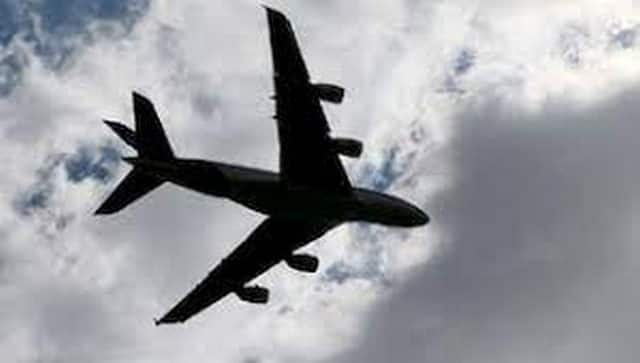If you’re travelling from the United States to Europe, you’ll have noticed that your trips are getting faster. No, it’s not in your imagination. A powerful jet stream over the Atlantic is now pushing planes at a speed equivalent to that of sound. But what is a jet stream? And how does this work? Let’s take a closer look: What is a jet stream? The US National Oceanic and Atmospheric Administration defines jet streams as “bands of strong wind”. These usually blow from west to east across the planet and influence weather, air travel and parts of our atmosphere. Earth has four main jet streams:
- Two polar jet streams near the planet’s poles
- Two subtropical jet streams near the equator
They are created when warm air masses and cold air masses collide in our atmosphere. The warm air, being warm, rises. And the cold air, being cooler, sinks. This in turn creates an air current. A jet stream is thus an air current that forms up high in the atmosphere, as per NOAA. How does it speed flights up? As per NOAA, jet streams and airplanes both fly in the same mid to upper troposphere. As per the website Simple Flying, jet streams can go at a speed of 128 to 225 kilometres per hour.
They can even hit as much as 442 kilometres per hour.
Thus, if the airplane slips into a jet stream going in the same direction, the aircraft naturally gets an extra push. This is why aircrafts going west to east over the Atlantic usually make the trip faster than aircrafts going in the opposite direction. [caption id=“attachment_13338412” align=“alignnone” width=“640”] Representational image.[/caption] As per the Simple Flying, the use of jet streams was first discovered in 1952 when a flight to Honolulu from Tokyo found its 18-hour journey cut to just 11.5 hours. Airlines have since put jet streams to good use while mapping their flight routes. As per the website AirLive, numerous flights to the UK departing from the United States touched a ground speed of 1,222 kmph. British Airways Boeing 787-10 hit that speed over Nova Scotia. Meanwhile, British Airways flight A350-1000 arrived at Heathrow from Las Vegas in just 8 hours and 45 minutes. The trip usually takes nearly 10 hours. Meanwhile, the website Flightware noted that Emirates flight 222 on 1 November reached its destination of Dubai from Dallas around an hour early. The flight hit a top speed of 777 mph off the coast of Newfoundland. It is also important to keep in mind the difference between ground speed and air speed. Air speed is defined as the speed of the plane relative to the air surrounding it, as per CNN. The website AirLive says air speed is the vector difference between the ground speed and wind speed. While the two would be the same on a day that is ‘perfectly still’, the air speed would be below the ground speed if the wind is going in the same direction that the aircraft is moving. CNN meteorologist Derek Van Dam explained: “Remember, ground speed is how fast an airplane is traveling, relative to a fixed point on the ground versus airspeed which is the speed of an aircraft relative to the air through which it is moving. Either way, these planes are saving time and money.” So these flights did not, like the Concorde, did not technically breach the sound barrier.
Representational image.[/caption] As per the Simple Flying, the use of jet streams was first discovered in 1952 when a flight to Honolulu from Tokyo found its 18-hour journey cut to just 11.5 hours. Airlines have since put jet streams to good use while mapping their flight routes. As per the website AirLive, numerous flights to the UK departing from the United States touched a ground speed of 1,222 kmph. British Airways Boeing 787-10 hit that speed over Nova Scotia. Meanwhile, British Airways flight A350-1000 arrived at Heathrow from Las Vegas in just 8 hours and 45 minutes. The trip usually takes nearly 10 hours. Meanwhile, the website Flightware noted that Emirates flight 222 on 1 November reached its destination of Dubai from Dallas around an hour early. The flight hit a top speed of 777 mph off the coast of Newfoundland. It is also important to keep in mind the difference between ground speed and air speed. Air speed is defined as the speed of the plane relative to the air surrounding it, as per CNN. The website AirLive says air speed is the vector difference between the ground speed and wind speed. While the two would be the same on a day that is ‘perfectly still’, the air speed would be below the ground speed if the wind is going in the same direction that the aircraft is moving. CNN meteorologist Derek Van Dam explained: “Remember, ground speed is how fast an airplane is traveling, relative to a fixed point on the ground versus airspeed which is the speed of an aircraft relative to the air through which it is moving. Either way, these planes are saving time and money.” So these flights did not, like the Concorde, did not technically breach the sound barrier.
Unfortunately, jet streams do have some drawbacks.
As the UK Met Office website notes, flights that arrive at their destination too early simply end up circling the skies and awaiting permission to land. Thus, airlines have to plan extensively. It also noted that jet streams can make things rather unpleasant for passengers in the form of turbulence. This current jet stream also has another major downside. As CNN meteorologist Sara Tonks explained, “The jet stream is expected to help strengthen Storm Ciaran, a low-pressure system and potential bomb cyclone that is expected to arrive in Europe tonight.” With inputs from agencies
)